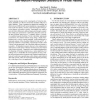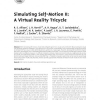19 search results - page 1 / 4 » Simulating Self-Motion I: Cues for the Perception of Motion |
93
Voted
VR
2002
IEEE
14 years 12 months ago
2002
IEEE
When people move there are many visual and non-visual cues that can inform them about their movement. Simulating self motion in a virtual-reality environment thus needs to take th...
105
Voted
VRST
2006
ACM
15 years 6 months ago
2006
ACM
Despite amazing advances in the visual quality of virtual environments, affordable-yet-effective self-motion simulation still poses a major challenge. Using a standard psychophysi...
102
Voted
VR
2002
IEEE
14 years 12 months ago
2002
IEEE
: When simulating self-motion, virtual reality designers ignore non-visual cues at their peril. But providing non-visual cues presents significant challenges. One approach is to ac...
84
Voted
ICRA
2010
IEEE
14 years 10 months ago
2010
IEEE
— This paper, divided in two Parts, considers the problem of realizing a 6-DOF closed-loop motion simulator by exploiting an anthropomorphic serial manipulator as motion platform...
197
Voted
CGF
2011
14 years 7 months ago
2011
Motion blur is a fundamental cue in the perception of objects in motion. This phenomenon manifests as a visible trail along the trajectory of the object and is the result of the c...



